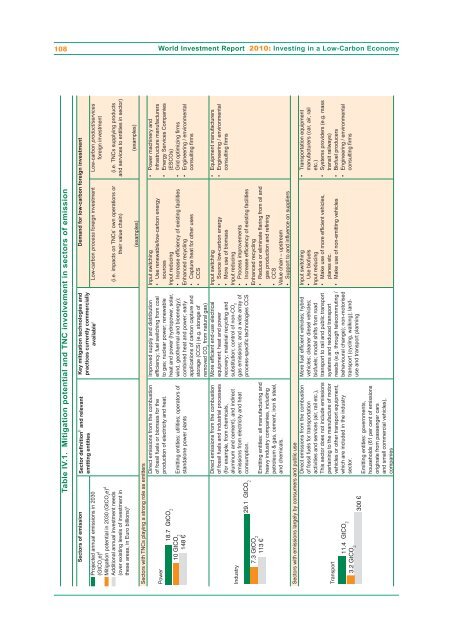UN World Investment Report 2010 - Office of Trade Negotiations
UN World Investment Report 2010 - Office of Trade Negotiations
UN World Investment Report 2010 - Office of Trade Negotiations
Create successful ePaper yourself
Turn your PDF publications into a flip-book with our unique Google optimized e-Paper software.
108<br />
Table IV.1. Mitigation potential and TNC involvement in sectors <strong>of</strong> emission<br />
Demand for low-carbon foreign investment<br />
Low-carbon product/services<br />
foreign investment<br />
Low-carbon process foreign investment<br />
Key mitigation technologies and<br />
practices currently commercially<br />
available c<br />
(i.e. TNCs supplying products<br />
and services to entities in sector)<br />
(i.e. impacts on TNCs’ own operations or<br />
their value chain)<br />
Sectors <strong>of</strong> emission Sector definition b and relevant<br />
emitting entities<br />
Projected annual emissions in 2030<br />
(GtCO e) 2 d<br />
Mitigation potential in 2030 (GtCO e) 2 d<br />
Additional annual investment needs<br />
(over existing levels <strong>of</strong> investment in<br />
these areas, in Euro billions) a<br />
(examples)<br />
(examples)<br />
<strong>World</strong> <strong>Investment</strong> <strong>Report</strong> <strong>2010</strong>: Investing in a Low-Carbon Economy<br />
Power machinery and<br />
infrastructure manufacturers<br />
Energy Services Companies<br />
(ESCOs)<br />
Grid optimizing firms<br />
Engineering / environmental<br />
consulting firms<br />
•<br />
•<br />
•<br />
•<br />
Input switching<br />
• Use renewable/low-carbon energy<br />
sources<br />
Input reducing<br />
• Increase efficiency <strong>of</strong> existing facilities<br />
Enhanced recycling<br />
• Capture heat for other uses<br />
• CCS<br />
Improved supply and distribution<br />
efficiency; fuel switching from coal<br />
to gas; nuclear power; renewable<br />
heat and power (hydropower, solar,<br />
wind, geothermal and bioenergy);<br />
combined heat and power; early<br />
applications <strong>of</strong> carbon capture and<br />
storage (CCS) (e.g. storage <strong>of</strong><br />
removed CO from natural gas)<br />
2<br />
More efficient end-use electrical<br />
equipment; heat and power<br />
recovery; material recycling and<br />
substitution; control <strong>of</strong> non-CO2 gas emissions; and a wide array <strong>of</strong><br />
process-specific technologies CCS<br />
Sectors with TNCs playing a strong role as emitters<br />
Direct emissions from the combustion<br />
<strong>of</strong> fossil fuels or biomass for the<br />
Power<br />
production <strong>of</strong> electricity and heat.<br />
18.7 GtCO<br />
2<br />
10 GtCO<br />
2<br />
Emitting entities: utilities; operators <strong>of</strong><br />
148 €<br />
standalone power plants<br />
Equipment manufacturers<br />
Engineering / environmental<br />
consulting firms<br />
•<br />
•<br />
Input switching<br />
• Source low-carbon energy<br />
• More use <strong>of</strong> biomass<br />
Input reducing<br />
• Process improvements<br />
• Increase efficiency <strong>of</strong> existing facilities<br />
Enhanced recycling<br />
• Reduce or eliminate flaring from oil and<br />
gas production and refining<br />
• CCS<br />
Value chain – upstream<br />
• Support to and influence on suppliers<br />
Direct emissions from the combustion<br />
<strong>of</strong> fossil fuels and industrial processes<br />
(for example, from chemicals,<br />
aluminum and cement), and indirect<br />
emissions from electricity and heat<br />
consumption.<br />
Industry<br />
29.1 GtCO 2<br />
Emitting entities: all manufacturing and<br />
heavy industry companies, including<br />
petroleum & gas, cement, iron & steel,<br />
and chemicals.<br />
7.3 GtCO<br />
2<br />
113 €<br />
Transportation equipment<br />
manufacturers (car, air, rail<br />
etc.)<br />
Systems providers (e.g. mass<br />
transit railways)<br />
Bi<strong>of</strong>uel producers<br />
Engineering / environmental<br />
consulting firms<br />
•<br />
•<br />
•<br />
•<br />
Input switching<br />
• Use bi<strong>of</strong>uels<br />
Input reducing<br />
• Make use <strong>of</strong> more efficient vehicles,<br />
planes etc.<br />
• Make use <strong>of</strong> non-emitting vehicles<br />
More fuel efficient vehicles; hybrid<br />
vehicles; cleaner diesel vehicles;<br />
bi<strong>of</strong>uels; modal shifts from road<br />
transport to rail and public transport<br />
systems and reduced transport<br />
needs (e.g. through telecommuting /<br />
behavioural change); non-motorised<br />
transport (cycling, walking); landuse<br />
and transport planning<br />
Sectors with emissions largely by consumers and public use<br />
Direct emissions from the combustion<br />
<strong>of</strong> fossil fuels for transportation<br />
activities and services (air, rail etc.),<br />
This sector does not include emissions<br />
pertaining to the manufacture <strong>of</strong> motor<br />
Transport<br />
vehicles or other transport equipment,<br />
11.4 GtCO which are included in the industry<br />
2<br />
3.2 GtCO sector.<br />
2<br />
300 €<br />
Emitting entities: governments,<br />
households (61 per cent <strong>of</strong> emissions<br />
originate from passenger cars<br />
and small commercial vehicles),<br />
companies

















